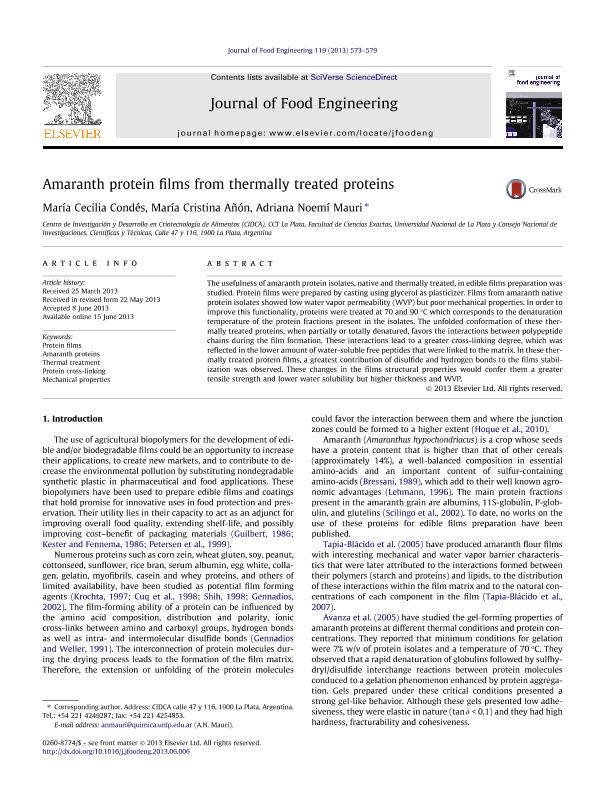Mostrar el registro sencillo del ítem
dc.contributor.author
Condes, María Cecilia

dc.contributor.author
Añon, Maria Cristina

dc.contributor.author
Mauri, Adriana Noemi

dc.date.available
2016-12-27T20:32:18Z
dc.date.issued
2013-12
dc.identifier.citation
Condes, María Cecilia; Añon, Maria Cristina; Mauri, Adriana Noemi; Amaranth protein films from thermally treated proteins; Elsevier; Journal Of Food Engineering; 119; 3; 12-2013; 573-579
dc.identifier.issn
0260-8774
dc.identifier.uri
http://hdl.handle.net/11336/10342
dc.description.abstract
The usefulness of amaranth protein isolates, native and thermally treated, in edible films preparation was studied. Protein films were prepared by casting using glycerol as plasticizer. Films from amaranth native protein isolates showed low water vapor permeability (WVP) but poor mechanical properties. In order to improve this functionality, proteins were treated at 70 and 90 C which corresponds to the denaturation temperature of the protein fractions present in the isolates. The unfolded conformation of these thermally treated proteins, when partially or totally denatured, favors the interactions between polypeptide chains during the film formation. These interactions lead to a greater cross-linking degree, which was reflected in the lower amount of water-soluble free peptides that were linked to the matrix. In these thermally treated protein films, a greatest contribution of disulfide and hydrogen bonds to the films stabilization was observed. These changes in the films structural properties would confer them a greater tensile strength and lower water solubility but higher thickness and WVP.
dc.format
application/pdf
dc.language.iso
eng
dc.publisher
Elsevier

dc.rights
info:eu-repo/semantics/openAccess
dc.rights.uri
https://creativecommons.org/licenses/by-nc-sa/2.5/ar/
dc.subject
Protein Films
dc.subject
Amaranth Proteins
dc.subject
Thermal Treatment
dc.subject
Protein Cross-Linking
dc.subject
Mechanical Properties
dc.subject.classification
Alimentos y Bebidas

dc.subject.classification
Otras Ingenierías y Tecnologías

dc.subject.classification
INGENIERÍAS Y TECNOLOGÍAS

dc.title
Amaranth protein films from thermally treated proteins
dc.type
info:eu-repo/semantics/article
dc.type
info:ar-repo/semantics/artículo
dc.type
info:eu-repo/semantics/publishedVersion
dc.date.updated
2016-12-12T14:09:25Z
dc.journal.volume
119
dc.journal.number
3
dc.journal.pagination
573-579
dc.journal.pais
Países Bajos

dc.journal.ciudad
Amsterdam
dc.description.fil
Fil: Condes, María Cecilia. Consejo Nacional de Investigaciones Científicas y Técnicas. Centro Científico Tecnológico la Plata. Centro de Investigaciones en Criotecnología de Alimentos (i); Argentina. Universidad Nacional de La Plata. Facultad de Ciencias Exactas; Argentina
dc.description.fil
Fil: Añon, Maria Cristina. Consejo Nacional de Investigaciones Científicas y Técnicas. Centro Científico Tecnológico la Plata. Centro de Investigaciones en Criotecnología de Alimentos (i); Argentina. Universidad Nacional de La Plata. Facultad de Ciencias Exactas; Argentina
dc.description.fil
Fil: Mauri, Adriana Noemi. Consejo Nacional de Investigaciones Científicas y Técnicas. Centro Científico Tecnológico la Plata. Centro de Investigaciones en Criotecnología de Alimentos (i); Argentina. Universidad Nacional de La Plata. Facultad de Ciencias Exactas; Argentina
dc.journal.title
Journal Of Food Engineering

dc.relation.alternativeid
info:eu-repo/semantics/altIdentifier/url/http://dx.doi.org/10.1016/j.jfoodeng.2013.06.006
dc.relation.alternativeid
info:eu-repo/semantics/altIdentifier/url/http://www.sciencedirect.com/science/article/pii/S0260877413002963
Archivos asociados
